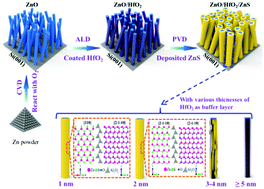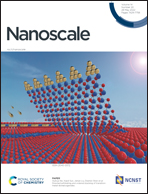Epitaxial growth of structure-tunable ZnO/ZnS core/shell nanowire arrays using HfO2 as the buffer layer†
Abstract
Synthesis of high-quality ZnO/ZnS heterostructures with tunable phase and controlled structures is in high demand due to their adjustable band gap and efficient electron–hole pair separation. In this report, for the first time, remote heteroepitaxy of single-crystalline ZnO/ZnS core/shell nanowire arrays has been realized using amorphous HfO2 as the buffer layer. Zinc blende or wurtzite ZnS epilayer can be efficiently fabricated under the same thermal deposition condition by adjusting the buffer layer thickness, even among the same batch of products, respectively. Structural characterization reveals “(01−10)ZnOwz//(2−20)ZnSZB, [0001]ZnOWZ//[001]ZnSZB” and “(01−10)ZnOWZ//(01−10)ZnSWZ, [0002]ZnOWZ//[0002]ZnSWZ” epitaxial relationships between the core and the shell, respectively. The cathodoluminescence measurement demonstrates that the tuning of the optical properties can be accomplished by preparing a heterostructure with HfO2, in which a strong green emission increases at the expense of the quenching of UV emission. In addition, the core/shell heterostructure based Schottky diode exhibits an asymmetrical rectifying behavior and an outstanding photo-electronic switching-effect. We believe that the aforementioned results could provide fundamental insights for epitaxial growth of structure-tunable ZnO/ZnS heterostructures on the nanoscale. Furthermore, this promising route buffered by the high-k material can broaden the options for fabricating heterojunctions and promote their application in photoelectric nanodevices.



 Please wait while we load your content...
Please wait while we load your content...